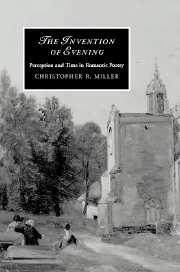Book contents
- Frontmatter
- Contents
- Acknowledgements
- Introduction
- 1 The pre-history of Romantic time
- 2 Coleridge's lyric “moment”
- 3 Wordsworth's evening voluntaries
- 4 Shelley's “woven hymns of night and day”
- 5 Keats and the “Luxury of twilight”
- 6 Later inventions
- Notes
- Bibliography
- Index
- CAMBRIDGE STUDIES IN ROMANTICISM
2 - Coleridge's lyric “moment”
Published online by Cambridge University Press: 04 May 2010
- Frontmatter
- Contents
- Acknowledgements
- Introduction
- 1 The pre-history of Romantic time
- 2 Coleridge's lyric “moment”
- 3 Wordsworth's evening voluntaries
- 4 Shelley's “woven hymns of night and day”
- 5 Keats and the “Luxury of twilight”
- 6 Later inventions
- Notes
- Bibliography
- Index
- CAMBRIDGE STUDIES IN ROMANTICISM
Summary
Samuel Taylor Coleridge's descriptions of his lyrics are famous for their defiance of traditional generic categories: “Effusion,” “Conversation Poem,” “A Poem which affects not to be Poetry,” “Sermoni propriora” (“more suited to colloquial speech”). These can be interpreted as the disclaimers of an unassuming poet, but also as the covert assertions of a theorist of organic form. Whatever hint of apology might once have attended the word “conversation” has faded away, first in G. M. Harper's canonical identification of a handful of lyrics as conversation poems, and more recently in the valorization of their skeptical and dialogic strategies as forms of Romantic irony. The poems that affected to formlessness have been credited by M. H. Abrams with founding the formal procedure of the “greater Romantic lyric,” in which a solitary speaker stations himself in a particular place, figuratively departs in a reverie of recollection or anticipation, and finally “returns” with a new sense of his situation. Abrams cogently identified the way that the Romantic lyric abstracted the excursions of eighteenth-century topographical poetry into mental movements; but I wish to show that in Coleridge's conversation poems, this form has a temporal as well as spatial dimension.
Many critics have noted the processual and dynamic nature of Coleridge's poems, but I mean more specifically to articulate their temporal and perceptual grammar. Far more than Wordsworth, Coleridge registers complex, wayward, ephemeral thoughts and sensations in time.
- Type
- Chapter
- Information
- The Invention of EveningPerception and Time in Romantic Poetry, pp. 48 - 80Publisher: Cambridge University PressPrint publication year: 2006



